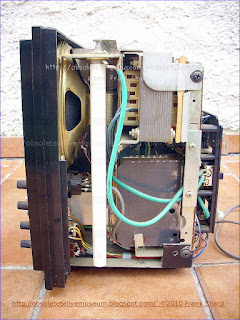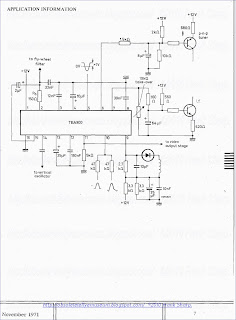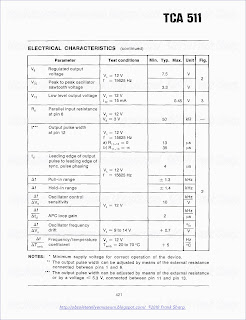BACKGROUND
The
invention relates to a tuning unit with bandswitch for high frequency
receivers, especially radio and television receivers, having a
potentiometer system for the control of capacity diodes, the said
potentiometer system consisting of a plurality of parallel resistance
paths along which wiper contacts can be driven by means of screw
spindles disposed adjacent one another in a common insulating material
housing in which a bandswitch formed of metal rods is associated with
each tuning spindle.
In these tuning units, the working voltages
of the capacity diodes in the tuning circuits are recorded once a
precise tuning to the desired frequency has been performed. A
potentiometer tuning system has great advantages over the formerly used
channel selectors operating with mechanically adjustable capacitors
(tuning condensers) or mechanically adjustable inductances
(variometers), mainly because it is not required to have such great
precision in its tuning mechanism.

Tuning units with
bandswitches formed of variable resistances and combined with
interlocking pushbuttons controlling the supply of recorded working
voltages to capacity diodes are known. Channel selection is accomplished
by depressing the knobs, and the tuning or fine tuning are performed
by turning the knobs. The resistances serving as voltage dividers in
these tuning units are combined into a component unit such that they
are in the form of a ladderlike pattern on a common insulating plate
forming the cover of the housing in which the tuning spindles and wiper
contacts corresponding to the variable resistances are housed. The
number of resistances corresponds to the number of channels or
frequencies which are to be recorded. The wiper contact picks up a
voltage which, when applied to the capacity diodes determines their
capacitance and hence the frequency of the corresponding oscillating
circuit. The adjustment of the wipers is performed by turning the
tuning spindle coupled to the tuning knob. By the depression of a
button the electrical connection between a contact rod and a tuning
spindle is brought about and thus the selected voltage is applied to
the capacity diodes. Since the push buttons release one another, it is
possible simply by depressing another button to tune to a different
receiving frequency or a different channel, as the case may be.
To
permit the switching of a number of channels in a certain tuning
range, bandswitches for a plurality of tuning ranges, such as UHF and
VHF for example, are often provided in the tuning units described
above. In the pushbutton tuning unit of the above-named type, the
bandswitch consists of a printed circuit board which is fastened on the
housing of the tuning unit, and a switch lever which is preset by
means of the pushbutton by turning, and is operated by depressing the
pushbutton while at the same time selecting the channel.
Where
this combination of knobs and pushbuttons is not possible, the
selection of the range is accomplished by means of an additional lever
which can be set over to select the range.
However, since such
tuning units require too many riveting operations when they are
assembled, tuning units were later created in which the individual
parts in the voltage divider and pushbutton housing were loosely
inserted and/or held in place by projections, lugs, hooks or tabs of
resilient plastic. In spite of these initial improvements, the
bandswitch, especially the one associated with the tuning units, was
still technically intricate and very expensive.
THE INVENTION
It
is the object of the invention, therefore, to create an additionally
improved and simplified tuning unit containing a bandswitch of simple,
space-saving and reliably operating design.
In accordance with
the invention, this object is accomplished in a tuning unit with
bandswitch of the kind described in the beginning by joining the tuning
spindles for rotation with sleeves simultaneously forming the control
knobs, which are mounted in apertures in the front plate of the housing
and have each a flange engaging the back of the front plate around the
aperture, the said flange being slightly larger than the aperture and
tapering conically away from the back of the front plate.
In
further development, the sleeves can be joined telescopically for
rotation with the tuning spindles, and the flange is able to engage the
back side of the front plate when the sleeve is in the position in
which it is drawn out of the front plate. The sleeves constructed in
this manner, whose portions projecting from the apertures in the front
plate form the control knobs for the tuning spindles, permit easy
assembly of the tuning unit
and at the same time assure positive co-rotation of sleeves and
spindles. The sleeves can be pushed from the front side of the front
plate through the apertures onto the clutch surfaces of the spindles,
this inward pushing being easily accomplished on account of the taper,
and the dropping out of the sleeve being prevented by the flange
engaging the back of the front plate. If the control knobs project only
slightly out of the front plate, they can be operated from the outside
by inserting a tool into them. With the telescoping type of coupling,
however, it is possible to draw the sleeves or control knobs further
outwardly so that they can be rotated by hand without the use of tools.
To
provide constant assurance of the axial fixation of the tuning
spindles, the tuning spindle ends farthest from the front plate can each
be provided with an annular groove engaged by a spring bracket whose
one leg is supported against the housing and whose other leg is forked
to form two spring arms, each bent in the opposite direction and each
engaging one of the two opposite walls of the annular groove. The tuning
spindles are secured against axial displacement by this construction
of the invention alone, without the need for further measures. This
facilitates the joining of the sleeves or control knobs to the tuning
spindle, because in this case there is no need for precise axial
fixation and extreme dimensional accuracy.
Furthermore, the
indicators associated with each potentiometer can be mounted in windows
in the front plate which are associated with each tuning spindle or
tuning knob for visual indication at the front, the other extremities
farthest from the front plate being mounted for pivoting on pins set in
the housing; the guiding pin on the spindle nut that is driven
longitudinally on each tuning spindle can be provided with a slit
disposed parallel to the long axis of the tuning spindles and can slide
within the indicator slide lever slot, with its surface resiliently
engaging the walls of said slot.
In an especially advantageous
embodiment, the tuning unit can have bandswitches each formed of a
displaceable metal rod which is in contacting engagement individually
with stationary metal rods which are common to all of the bandswitches
of a tuning unit. It contrast to the bandswitches known hitherto, which
as a rule consist of a printed circuit board with switchable contacts
thereon, this frequency bandswitch of the invention is of great
simplicity, can be manufactured simply and inexpensively, and at the
same time is very reliable in operation.
The displaceable and
stationary metal rods of the bandswitches can be formed of metal wires
or they can be of stamped sheet metal. Also, in further expansion of the
concept of the invention, the stationary metal rods thus formed can be
all entirely alike and merely offset from one another, thereby further
simplifying the manufacture and stocking thereof.
To permit
connection also to audiovisual apparatus, one or more of the stationary
metal rods can be divided electrically into at least two parts each.

In
a special development of this concept, lugs of insulating material can
be mounted on the front ends of the displaceable metal wires, these
lugs extending through windows in the front plate of the housing which
are associated with each tuning spindle and are provided with detents,
while the opposite ends can be held fixedly at the rear end of the
housing, and the displaceable metal wires can make contact with contact
humps on the stationary metal wires, the humps being offset from one
another to correspond to the detents in the windows, and the stationary
metal wires extending in back of the front plate, parallel to the
latter and parallel to one another.
To increase switching
reliability, bridges or sliding pieces made of insulating material can
be inserted between the contact humps of adjacent stationary wires
within the free space between two such parallel lying metal wires.
To
achieve easy displacement of the displaceable metal wires despite the
fixed end mounting on the housing, the displaceable metal wires, in
further embodiment of the invention, can have each an articulation
adjacent their end mountings, in the form of a vertically disposed
flattened portion. This flat permits the metal wires to be deflected
horizontally against a weak spring bias.
DESCRIPTION OF THE DRAWING
As
an example of the embodiment of the invention, there is represented in
the drawings a tuning unit with bandswitch for television receivers.
In these drawings,
FIG. 1 is a front elevational view of a tuning unit with bandswitch,
FIG. 2 is a plan view showing the bandswitch of the tuning unit of FIG. 1,
FIG. 3 is a side elevational, cross-sectional view of the tuning unit of FIG. 1,
FIG. 4 is a rear elevational view of the tuning unit of FIG. 1,
FIG. 5 is a plan view showing the indicator means of the tuning unit of FIG. 1,
FIG. 6 shows the sleeve with the operating knob and tuning spindle,
FIG. 7 shows the telescoping manner in which the sleeve is joined to the tuning spindle,
FIG. 8 is a fragmentary view of the bandswitch,
FIG. 9 is another fragmentary view of the bandswitch, and
FIG. 10 shows how the tuning spindle is fixed in position.
DESCRIPTION
The method of representation used in the drawings is greatly simplified, for the purpose of better del

ineating
the features of the invention. The tuning unit with bandswitch
consists of an insulating material housing 1 with a front plate 2,
which is closed by a cover plate 3 accommodating the resistance paths.
The housing 1 is divided by parallel sidewalls 4 into chambers in which
the tuning spindles 5 are disposed.
The embodiments is an 8-fold tuning unit having eight bandswitches assocated with each tuning spindle, and eight indicators.
Accordingly,
there are eight apertures 6 in a central row, through which the
operating knobs 7 of the sleeves 8 coupled with the tuning spindles 5
are passed. The operating knobs 7 have recessed surfaces 9 for turning
with a turning tool. In a row extending parallel above the row of the
apertures 6 there are eight windows 10, whose upper edge is provided
with notches 11. Lugs 12 of insulating material extend through the
windows 10 and engage the upper notches 11 and are joined behind the
front plate to displaceable metal wires 13 of the bandswitch. In a row
located beneath the row of apertures 6 another eight windows 14 are
provided, through which the ends of the pointers of the indicators 15
protrude.
Now, the bandswitch consists in each case of a
displaceable metal wire 13 which can be brought into working engagement
with stationary metal wires 16, which are all of the same construction
and are only disposed offset from one another. While the displaceable
metal wire 13 extends substantially parallel to the longitudinal axis
and thus at right angles to the front plate 2, the stationary,
parallelly disposed metal wires 16 are parallel to the front plate 2 and
are thus inserted at a right angle to the displaceable metal wire. A
departure from parallelism or from the right angle, as the case may be,
takes place substantially only when the displaceable metal wire 13 is
deflected to the two outer notches. The rearward end 18 of the
displaceable metal wire, which forms a vertical loop, is tightly
inserted into a receiver 17. Just ahead of the loop 18, the metal wire
13 is provided with a vertically disposed portion 19 by a flattening on
the metal wire 13. The movement, when the metal wire 13 is deflected
into the desired notches or detents, takes place horizontally by the
flex

ing
of these portions 19. The stationary metal wires 16 are held tightly
in their positions in projections 20 on the housing, or by lugs or the
like. Since three switch actions are provided, that is, three ranges,
for each tuning spindle, a bandswitch consists of one displaceable metal
wire and three stationary metal wires 16, which are used for all
switches.
To permit each bandswitch to have exactly three
switching actions, each of the three stationary metal wires 16 has one
contact hump 21 corresponding to one of the detents 11 in the windows 10
of the front plate 2. The contact humps 21 are thus located one next
to the other as seen from the front plate 2. So that the displaceable
metal wire 13 will always come into mechanical and electrical contact
only with the desired contact hump, and prevent short circuits,
insulating bridges 22 are installed between the adjacent metal wires 16,
said insulating bridges being stationary.
If more or less than
three switching actions are desired, all that need be done in the case
of the bandswitch of the invention is to change the number of
stationary metal rods or wires accordingly.
The sleeves 8 with
the operating knob 7 have a flange 23 engaging the back of the front
plate 2 and tapering back to the point where it joins the tuning
spindle. This enables the sleeves to be pushed in, in the case of a
housing that has already been manufactured with the tuning spindle
installed, without creating the possibility that the sleeves 8 might
escape after they have been inserted. The sleeves 8 are connected to
the tuning spindles 5 usually by means of driving surfa

ces.
If manual operation without tools is to be possible, rather than
requiring a tool for the operation of the sleeves, the coupling of the
sleeve 8 to the tuning spindle will be a telescoping coupling (see FIG.
7).
The actual firm axial fixation of the tuning spindle 5 is
located on the rear end of the housing. Here the tuning spindle 5 has an
annular groove 24 which is engaged by a spring by means of two
diametrically disposed spring arms 25 and 26. The spring arms 25 and 26
have oppositely curved lugs and are supported on the housing at their
terminal and marginal surfaces and their lugs engage opposite axial
walls 27 and 28 of the annular groove 24.
Additional support is provided by the common, bent foot 29 of the spring arms 25 and 26 against the cover plate of the housing.
The indic

ator
means of the tuning unit with bandswitch consists of a pointer 15
which is movable within the window 14, and a cam 30 which is a
prolongation of the pointer 15. At its rearward end, the pointer is
mounted rotatably in the housing on pin 31. Within the cam 30 slides a
guiding pin 32 which is attached to the spindle nut or carriage 40.
Upon the rotation of the tuning spindle, the spindle nut is
longitudinally displaceable therewith. In order to achieve good
guidance and hence precise indication, the guiding pin has a slit 33
extending parallel to the longitudinal axis of the tuning spindle 5, so
that it will resiliently engage the cam 30 within the slot thereof.
The necessary soldering lugs are indicated at 34.
On
the basis of the design of the tuning unit with bandswitch in
accordance with the invention, a desired frequency range--UHF, for
example--can be selected by deflecting a displaceable metal wire 13 into
one of the detents 11 by means of the lug 12 mounted thereon. Within
this range, a transmitter or channel can then be selected by turning the
tuning spindle 5. The transmitter preselected in th

is
manner can then be tuned in by means of a keyboard or by electronic
recall from a keyboard which is not shown. The fine tuning of this
tuned-in transmitter, as well as the selection of a different
transmitter within the same frequency range, is accomplished by turning
the tuning spindle 5.
All of the details explained in the above description and represented in the drawings are important to the invention.

























































